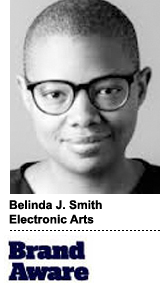 “Brand Aware” explores the data-driven digital ad ecosystem from the marketer’s point of view.
“Brand Aware” explores the data-driven digital ad ecosystem from the marketer’s point of view.
Today’s column is written by Belinda J. Smith, global director of media activation at Electronic Arts.
As anyone who is hiring media buyers knows, there is a talent shortage in the industry. Brands trying to build in-house teams are often faced with junior talent who are commanding high salaries, perks and special treatment in what is most certainly a job-seekers’ market.
High churn due to a hypercompetitive job market is one of the things that many marketers and agencies have come to accept. I believe, however, that churn is something we can overcome. If companies make the right – though sometimes tough – decisions from the start, they can severely mitigate churn. There are buyers at EA who have been here since we started in-housing three years ago.
What is hardest (for me) about getting the right talent is saying no to really good candidates – especially in such a tough market. However, if they aren’t a total fit for all of your needs, saying no is the best thing to do.
Here are some questions I use when evaluating candidates and deciding whether to take the plunge.
1. Are they here for the right reasons?
The competitiveness of our industry allows bad talent to float from one company to the next in short bursts without having to address (or even admit) their shortcomings.
While the right reasons will differ from situation to situation, it’s usually very easy to spot the wrong reasons. It often sounds something like “I hate my job/team/manager,” “How much do you pay?” or “I need a better title.”
These are not necessarily bad reasons to look for a new job, but if a candidate is coming with a list of grievances, it’s usually a red flag.
2. Are they a cultural fit?
AdExchanger Daily
Get our editors’ roundup delivered to your inbox every weekday.
Daily Roundup
Just because a candidate is a media buying genius doesn’t mean he or she will be a good fit for the team.
While I want people with great role-related skills, what’s equally important is maintaining the company culture. One of the biggest mistakes I could make for the candidate and the team would be to bring someone in who doesn’t embrace my company’s values.
In the best case, they are marginally productive but not happy or growing. In the worst case, the company culture erodes over time into something unintended as bad hires start to overshadow the team.
3. What value do we place on this type of talent?
I have worked for companies that pay absolute top dollar to get who they want, and I’ve also worked for companies with inflexible salary bands applied blindly to every candidate. Neither approach is great.
Instead, think about the next promotion cycle and ensuring you bring the candidate in with room for salary and title growth based on their scope. Otherwise, you could end up with overpaid candidates who have no room for increases or candidates who are undervalued and you hope don’t discover how much more they should be earning. Both situations increase the probability of churn.
4. What can we offer them?
I sometimes see great candidates who I pass on because we can’t provide what they need to flourish. If we can’t help a candidate explore their interests, improve their weaknesses and shine for their strengths, it’s not a fit.
It’s hard, if not impossible, to convince someone to be inspired in a role they find limiting, misaligned or stifling, especially in digital. People come to this profession excited by the rapid change and the challenge of the work. As I once told a group during an ANA meeting: You’re crazy if you think your team is here to adjust settings in a demand-side platform (DSP) all day.
5. Are we focusing on diversity?
This is the absolute most important question. To be a truly player-first organization, EA should reflect the diverse nature of our players, just as brands in general should reflect the diversity of their customers.
More than checking a box or filling a quota, brands must hire for diverse candidates continually to ensure that they are not alone when they arrive and encourage supportive communities within the workplace, such as mentorship and employee resource groups. If you hire the same people you’ve always hired, you’ll get the same ideas you’ve always gotten.
We all know how that story ends.
Follow Belinda J. Smith (@BJStech), Electronic Arts (@EA) and AdExchanger (@adexchanger) on Twitter.












